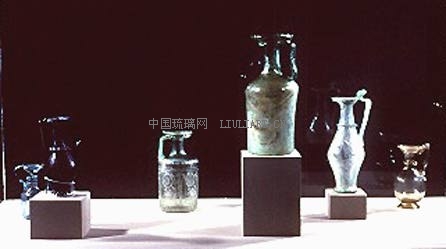THE BACKGROUND OF GLASS
Glass is formed when sand (silica), soda (alkali), and lime are fused at high temperatures. The color of the glass can be altered by adjusting the atmosphere in the furnace and by adding specific metal oxides to the glass "batch" (such as cobalt for dark blue, tin for opaque white, antimony and manganese for colorless glass). A venerable legend perpetuated as late as the seventh century A.D. in the writings of Isidore of Seville gives a suitable miraculous explanation for the discovery of this elemental--yet truly wondrous--material:
This was its origin: in a part of Syria which is called Phoenicia, there is a swamp close to Judaea, around the base of Mt. Carmel, from which the Bellus River arises . . . whose sands are purified from contamination by the torrent's flow. The story is that here a ship of natron [sodium carbonate] merchants had been shipwrecked; when they were scattered about on the shore preparing food and no stones were at hand for propping up their pots, they brought lumps of natron from the ship. The sand of the shore became mixed with the burning natron and translucent streams of a new liquid flowed forth: and this was the origin of glass.
(Isidore of Seville, Etymologies XVI.16. Translation by Charles Witke.)

It is not surprising that the ancient authorities thought of Phoenicia as the birthplace of glass, for the Syro-Palestine region did indeed become a major center of glass production in antiquity, along with Egypt. However, glass seems actually to have been "discovered" not in Phoenicia, but in Mesopotamia. Archaeological research now places the first evidence of true glass there at around 2500 B.C. At first it was used for beads, seals, and architectural decoration. Some 1,000 years elapsed before glass vessels are known to have been produced. Vessels of glass quickly became widespread in the second half of the second millennium B.C. They were popular not only in Mesopotamia but also in Egypt and the Aegean.
The earliest vessels were core-formed. Opaque, dark glass in its molten state was wound around a clay core attached to a metal rod. The skin of hot glass was fashioned with tools in order to shape its external features. Lighter colored strands of hot glass were then trailed on the surface and often "dragged" to produce festoon patterns. The pot surface was marvered (that is, rolled on a smooth, flat surface to produce a level finish). Finally, it was cooled slowly before the clay core was scraped out of the hardened vessel. This glassware typically imitated forms originally established for ceramic, metal, and stone vessels .
Somewhat later, the molding technique was developed, whereby glass chips or molten glass were packed or forced into a mold and then fused. After a molded vessel was annealed (cooled slowly in a special chamber of the glass furnace), it was often ground and polished in order to refine the rim and any other rough edges. One typical shape for molded vessels of the late Hellenistic and early Roman periods (c. 150 -50 B.C.) was the so-called pillar-molded bowl. Here exterior ribs radiate up from the base, stopping abruptly near the rim to allow a smooth margin around the circumference.
This type is ubiquitous; and it attests to the free and rapid exchange of ideas in glass-making throughout the Greater Mediterranean sphere. Fragmentary examples in the collections of the Kelsey Museum range from Seleucia, to Karanis, to Puteoli. The site of Tel Anafa in Israel (recently excavated jointly by the Universities of Michigan and Missouri) has provided critical information on the chronological limits of these bowls within the Roman period.
Around 50 B.C. a revolutionary development occurred in the history of glass-making: the invention of free-blowing. This landmark achievement did almost certainly take place in Syro-Palestine even if the basic discovery of glass did not. Perhaps the significance attached to the Syro-Palestine glasshouses because of the discovery there of the blowing technique is at the root of the ancients' tendency to attribute to Phoenicia the invention of the actual material as well.
The free-blowing process required a continuously fired furnace.
A wad of molten glass was gathered on the end of a long metal pipe. By blowing air through this pipe, the molten "gather" became a bubble of glass that could be manipulated with tools and reheated periodically for easier working. After the application of elements such as base-pedestals, a metal rod ("pontil rod") was thrust onto the bottom of the vessel and the top was cracked off the blow-pipe.
Then, with further reheating, the top of the vessel received its final shaping; and elements such as handles and decorative trails were applied from a molten gather. Vessels produced in this way often preserve a scar, or "pontil mark," on the base from the removal of the pontil rod. When complete, the vessel was placed in the annealing chamber of the furnace.
[1] [2] [3] [4] [5] [6] [7] [8] 下一页
|




